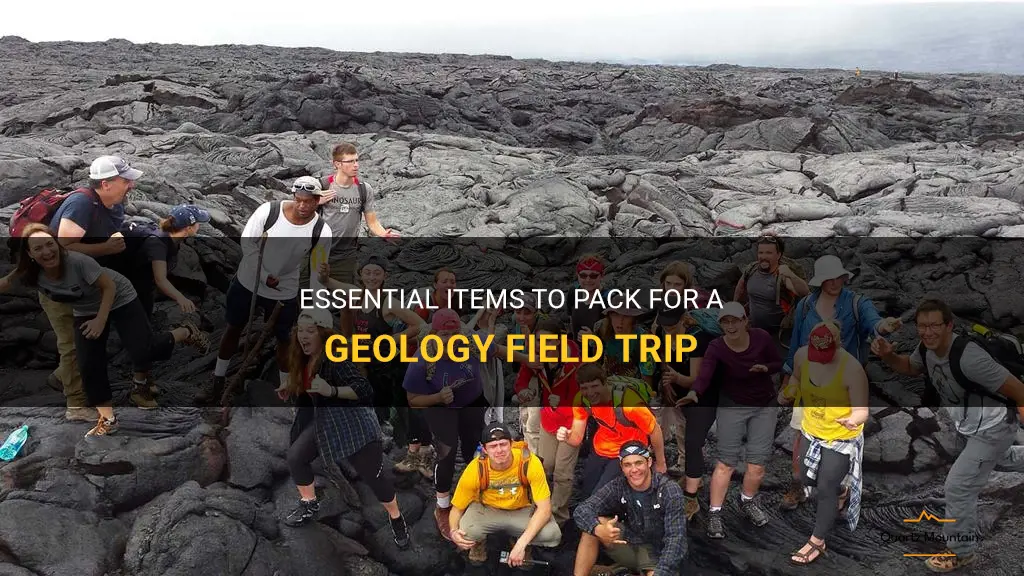
Going on a geology field trip soon? Whether you're a seasoned geologist or a curious student, one thing is certain: packing the essential items is crucial for a successful and enriching experience. From sturdy hiking boots to a trusty field notebook, there's a list of must-haves that will ensure you're prepared for any rock-hunting adventure that awaits. So, grab your rock hammer and get ready to discover the essential items to pack for a geology field trip!
| Characteristics | Values |
|---|---|
| Comfortable clothing | ✔️ |
| Sturdy hiking boots | ✔️ |
| Hat and sunglasses | ✔️ |
| Sunscreen and insect repellent | ✔️ |
| Water bottle | ✔️ |
| Snacks and packed lunch | ✔️ |
| Field notebook and pens | ✔️ |
| Compass and map | ✔️ |
| Hand lens and rock hammer | ✔️ |
| GPS device | ✔️ |
| First aid kit | ✔️ |
| Camera | ✔️ |
| Portable charger | ✔️ |
What You'll Learn
- What essential tools and equipment should be included in a geology field trip packing list?
- What type of clothing and footwear is most suitable for a geology field trip?
- Are there any specific safety precautions or items that should be considered when packing for a geology field trip?
- Are there any specific geological field guides or reference materials that should be included in the packing list?
- What type of food and drinks are recommended for a geology field trip, considering the duration and physical activity involved?

What essential tools and equipment should be included in a geology field trip packing list?
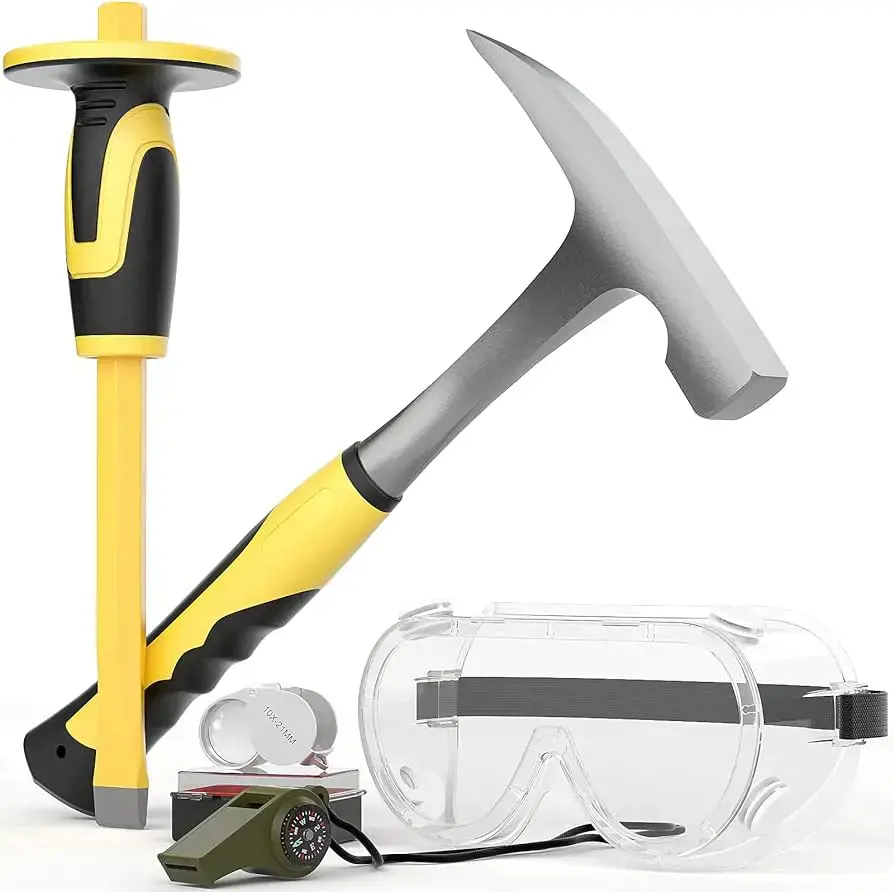
When planning for a geology field trip, it's crucial to pack the right tools and equipment to ensure a successful and productive experience. Geology fieldwork often involves collecting rock samples, studying rock formations, and analyzing various geological features. To help you prepare, here is a list of essential tools and equipment that should be included in your geology field trip packing list.
- Rock Hammer: A rock hammer is perhaps the most important tool for any geologist. It allows you to break open rocks to observe their internal structures and collect samples. The two main types of rock hammers are the chisel-tipped and the pointed-tip hammer, each serving different purposes. Make sure to choose a high-quality, sturdy rock hammer that will withstand the demanding conditions of fieldwork.
- Hand Lens: A hand lens, also known as a magnifying lens or loupe, is essential for close-up examination of rocks, minerals, and geological features. It helps magnify small details and identify mineral properties such as color, crystal structure, and cleavage. Opt for a hand lens with a high magnification power, such as 10x or 20x, to observe finer details.
- Field Notebook: A field notebook is indispensable for recording observations, measurements, and sketches during a geology field trip. It serves as a written record of your findings and can be used for later analysis. Choose a waterproof notebook with sturdy pages that can withstand outdoor conditions, and don't forget to bring several pens or pencils.
- GPS Device or Compass: Navigational tools are crucial for accurately recording the location of geological features during fieldwork. A GPS device can provide precise coordinates, while a compass can help determine directions. Make sure to learn how to use these tools beforehand and bring spare batteries or a charging cable.
- Sample Bags or Containers: When collecting rock or mineral samples, it's important to have a supply of sample bags or small containers with secure lids. These will protect the samples from getting contaminated or damaged during transportation. Label each sample with relevant information such as the location, date, and description for proper identification later.
- Safety Equipment: Safety should always be a top priority during a geology field trip. Depending on the specific location and geological hazards present, safety equipment may include items such as hard hats, safety goggles, gloves, and sturdy boots. It's essential to research and understand the potential risks of the field site in advance.
- Field Maps and Geologic Charts: To better understand the geological context and formations of the area you'll be visiting, bring field maps and geologic charts. These resources can provide valuable information about the local geology and help guide you to areas of interest.
- Portable Field Laboratory: If you will be conducting fieldwork that requires immediate analysis or testing, consider bringing a portable field laboratory. This may include items such as a hand-held X-ray fluorescence (XRF) analyzer, a portable microscope, or a geochemistry kit. These tools can provide on-site data and enhance the efficiency of your research.
- Safety Whistle and First Aid Kit: Always be prepared for unexpected situations in remote field locations. Pack a safety whistle and a first aid kit that includes essentials such as bandages, antiseptic wipes, pain relievers, and any necessary personal medication.
- Water and Snacks: Lastly, don't forget to stay hydrated and energized throughout the field trip. Carry a sufficient amount of water in a reusable bottle and pack nutritious snacks that will sustain you during long hours outdoors.
In conclusion, a geology field trip necessitates careful planning and packing. By including essential tools and equipment like a rock hammer, hand lens, field notebook, GPS device or compass, sample bags or containers, safety equipment, field maps, portable field laboratory, safety whistle, and first aid kit, you will be well-prepared to explore and study the geological wonders of your chosen location. Remember to conduct thorough research and consult with experienced geologists to ensure you have all necessary gear for a successful and productive field trip.
Essential Items to Pack for Your Bali Vacation
You may want to see also

What type of clothing and footwear is most suitable for a geology field trip?
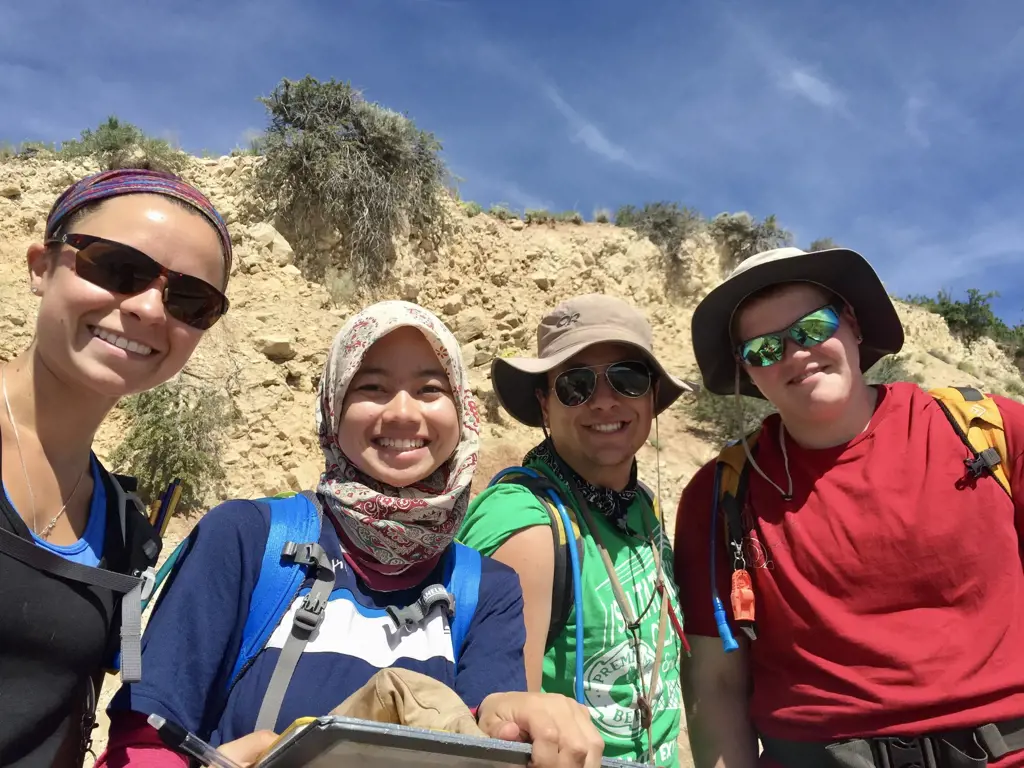
Going on a geology field trip can be an exhilarating and educational experience. Whether you are a student, researcher, or enthusiast, proper clothing and footwear are crucial for ensuring your comfort and safety during your expedition. In this article, we will explore the most suitable clothing and footwear options for a geology field trip.
Protective Outerwear:
The weather can be unpredictable in outdoor settings, so it is important to be prepared for all conditions. A waterproof and windproof outer layer, such as a rain jacket or shell, is essential to protect against rain, wind, and the occasional splashes encountered during fieldwork. Opt for lightweight and breathable materials to avoid overheating.
Layered Clothing:
Layering is key when it comes to dressing for a geology field trip. It allows you to adjust your clothing according to the fluctuating weather conditions and physical activity levels. Start with a moisture-wicking base layer to keep you dry and comfortable. Add a mid-layer, such as a fleece or synthetic insulation, for warmth. Lastly, top it off with a waterproof and breathable outer layer.
Durable Pants:
A pair of durable and water-resistant pants is a must-have for a geology field trip. Opt for pants made of quick-drying materials, such as nylon or polyester, to keep you comfortable even in wet conditions. Look for pants with reinforced knees and seat for added durability and protection against rough terrain.
Sturdy Footwear:
Investing in a pair of sturdy and supportive footwear is essential for a geology field trip. Look for hiking boots or trail shoes with ankle support to prevent sprains and injuries on uneven terrain. Make sure the footwear has a good grip and traction to provide stability on slippery surfaces. It is advisable to break in your footwear before the field trip to avoid blisters and discomfort.
Socks and Gaiters:
Wearing the right socks is just as important as having the right footwear. Opt for moisture-wicking and cushioned socks to prevent blisters and provide extra comfort during long hikes. Additionally, consider using gaiters to protect your lower legs from debris, dust, and water, especially when traversing rocky or muddy terrains.
Hat and Sunglasses:
Protecting yourself from the sun is crucial during a geology field trip. Wear a wide-brimmed hat to shield your face and neck from direct sunlight and prevent sunburn. Sunglasses with UV protection are also essential to protect your eyes from harmful rays and glare.
Gloves and Bandanas:
Depending on your fieldwork activities, it may be helpful to bring along a pair of gloves to protect your hands from sharp rocks, thorny bushes, or cold weather. Bandanas can be versatile accessories, keeping your neck protected from the sun or acting as a dust mask in dusty or windy conditions.
By following these clothing and footwear recommendations, you can ensure that you are well-prepared for a geology field trip, regardless of the weather or terrain conditions. Remember to also pack essentials like sunscreen, a water bottle, and a backpack to carry your equipment and samples. Happy exploring!
Essential Items to Pack for Head Coverage While Traveling in India
You may want to see also

Are there any specific safety precautions or items that should be considered when packing for a geology field trip?
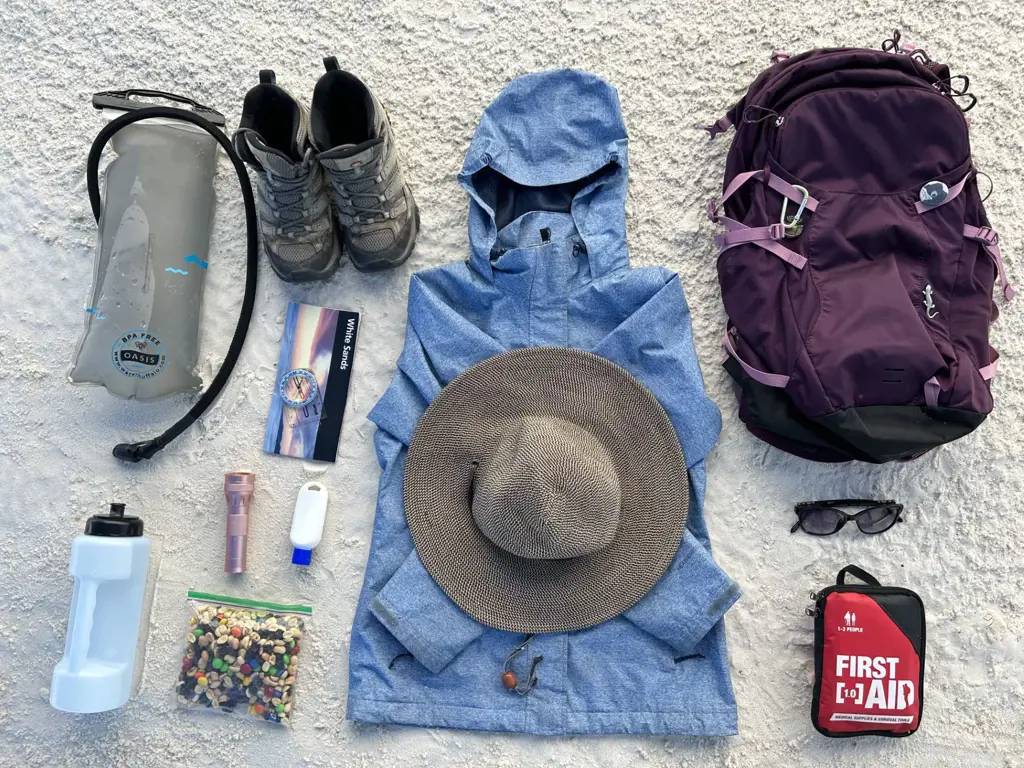
When it comes to packing for a geology field trip, it is essential to consider the safety aspect in addition to bringing the necessary tools and equipment. Geology field trips often involve visiting areas with rugged terrain, potentially hazardous weather conditions, and exposure to various geological hazards. To ensure a safe and successful trip, here are some crucial safety precautions and items to consider including in your packing list:
Personal Protective Equipment (PPE):
PPE is essential for personal safety during a geology field trip. It includes items such as a hard hat to protect your head from falling rocks or debris, safety goggles or glasses to shield your eyes from dust or harmful particles, sturdy boots with ankle support to prevent injuries on uneven terrain, and high-visibility clothing to increase your visibility to others in the field.
First Aid Kit:
Accidents can happen in remote locations, so having a well-equipped first aid kit is crucial. The kit should include items such as bandages, antiseptic wipes, painkillers, emergency medications (if applicable), a snakebite kit (if visiting areas with venomous snakes), and any personal medications you may require.
Communication and Navigation Devices:
Being able to communicate with your group and emergency services is vital in case of emergencies. Pack a fully charged cell phone, a satellite phone (if available), and a two-way radio for areas with limited or no cell service. Additionally, bring a compass, GPS device, or maps and a compass to navigate through unfamiliar terrain.
Weather Protection:
Weather conditions can change rapidly during a geology field trip, so it is important to be prepared. Pack a waterproof jacket or raincoat, warm layers of clothing, gloves, and a hat to protect against cold temperatures. Sun protection is also essential, so bring sunscreen, a hat, sunglasses, and lightweight, breathable clothing to protect against the sun's harmful rays.
Field Equipment:
Depending on the objectives of your geology field trip, you may need to bring specific tools and equipment. This can include a rock hammer or geologic hammer for collecting samples, a hand lens or magnifying glass for closer examination of rocks and minerals, a field notebook and writing materials for recording observations, and sampling bags or containers for collecting and storing samples.
Field Guides and Reference Materials:
Having access to field guides and reference materials specific to the geological region you are visiting can greatly enhance your understanding and appreciation of the surroundings. These resources can help you identify different rock types, fossils, and geological formations you encounter during the trip.
Emergency Preparedness:
In addition to packing the necessary safety equipment, it is crucial to have a plan in case of emergencies. Familiarize yourself with the emergency procedures of the area, including the location of the nearest medical facility, emergency contact numbers, and evacuation routes. Share this information with your field trip companions and ensure someone outside of the group is aware of your itinerary and expected return date.
It is essential to remember that safety should always be the top priority during a geology field trip. Taking necessary precautions, being prepared for emergencies, and having the right equipment and knowledge will help ensure a safe and successful experience in the field.
Essential Items to Pack for a 24-Hour Challenge
You may want to see also

Are there any specific geological field guides or reference materials that should be included in the packing list?
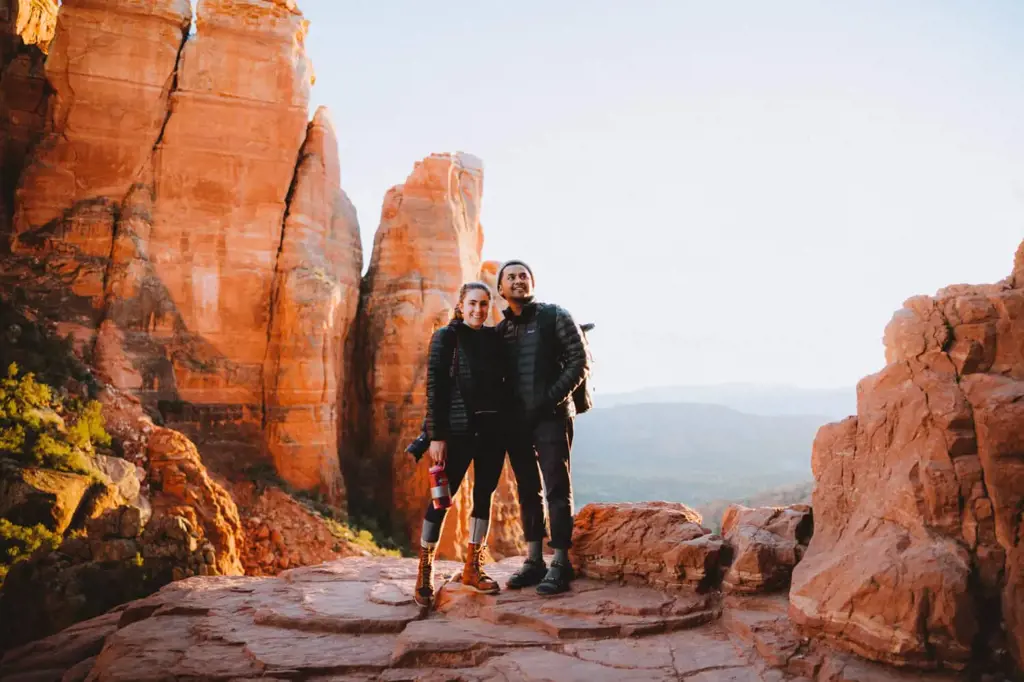
When heading into the field as a geologist, it's important to have the necessary field guides and reference materials to aid in identifying rock formations, interpreting geological features, and understanding the geology of the area you are studying. Here are some specific geological field guides and reference materials that should be included in your packing list:
- Rock and Mineral Identification Guides: These guides provide detailed information on the identification of different rock types and minerals. They typically include color photographs, physical properties, and key distinguishing features to help you identify rocks and minerals in the field. Some popular guides include "National Audubon Society Field Guide to North American Rocks and Minerals" and "A Field Guide to Rocks and Minerals" by Frederick H. Pough.
- Geological Maps: Geological maps are an essential tool for understanding the geology of an area. They show the distribution of different rock formations, faults, and other geological features. These maps can help you navigate through the field and interpret the geological history of the area. The "Geological Map of [the region you are studying]" should be acquired before heading into the field.
- Field Notebooks: A geological field notebook is essential for recording observations, taking measurements, and documenting your findings in the field. It should include a durable and waterproof cover, grid or lined pages for sketching and note-taking, and a pencil or waterproof pen. The notebook should also have space to record GPS coordinates, weather conditions, and other relevant data.
- Geological Field Guides: These guides are specific to a particular region or geological formation. They provide a comprehensive overview of the local geology, including rock types, sedimentary structures, and fossils. Examples of geological field guides include "The Geology of [the region you are studying]" by [author], which can provide vital information about the geology of the area.
- Fossil Identification Guides: If you are studying an area with significant fossil deposits, it is important to have a fossil identification guide. These guides help identify fossils based on their characteristics, such as shape, size, and geological age. Examples of fossil identification guides include "National Audubon Society Field Guide to Fossils" and "Fossils: A Guide to Prehistoric Life" by Richard Fortey.
- Geologic Time Scale: The geologic time scale is a reference tool that organizes Earth's history into eons, eras, periods, and epochs. It provides a framework for understanding the relative ages of rocks and fossils and the sequence of events that have shaped the Earth. Having a geologic time scale handy can help in interpreting the age and relationships between different rock formations.
- Geotechnical Manuals: If your fieldwork involves engineering or environmental geology, it is essential to have geotechnical manuals for reference. These manuals provide guidelines for soil and rock classification, laboratory testing procedures, and geotechnical engineering calculations. Examples of geotechnical manuals include "Manual of Soil Laboratory Testing" by K.H. Head and "Rock Slope Engineering" by Evert Hoek and John Bray.
In summary, packing the right field guides and reference materials is crucial for effective geological fieldwork. They assist in rock and mineral identification, interpretation of geological features, documentation of observations, and understanding the geology of the area you are studying. Including rock and mineral identification guides, geological maps, field notebooks, geological field guides, fossil identification guides, a geologic time scale, and geotechnical manuals will ensure you have the necessary resources to make the most of your fieldwork experience.
The Essential Food Packing Guide for College Students
You may want to see also

What type of food and drinks are recommended for a geology field trip, considering the duration and physical activity involved?
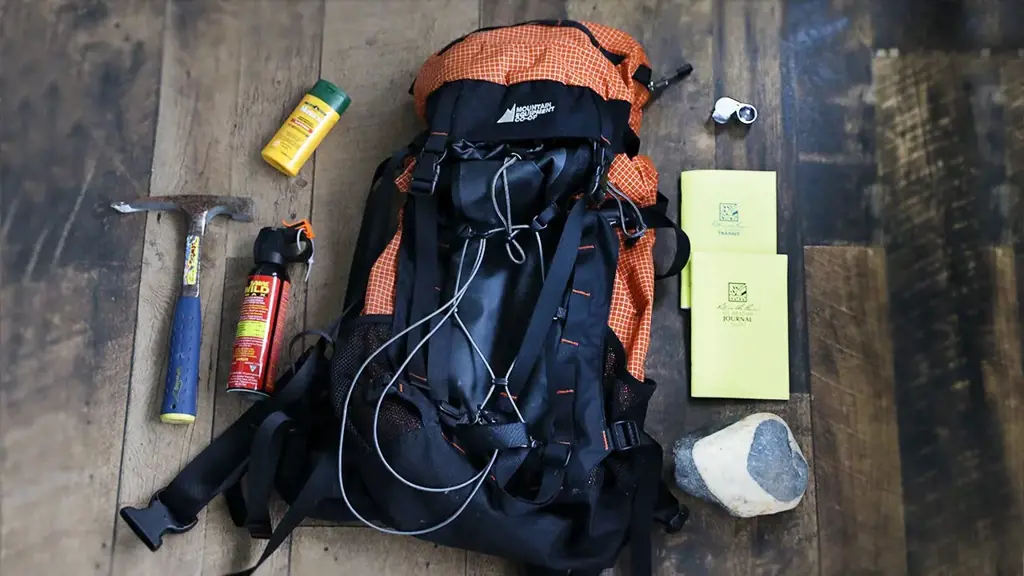
When planning a geology field trip, it is essential to consider the type of food and drinks that will be practical and beneficial for the participants. Geology field trips often involve long periods of physical activity and can last for several hours to even days. Therefore, it is important to choose food and drinks that will provide sustained energy, hydration, and nutrition.
One crucial factor to consider is the duration of the field trip. For shorter trips, a packed lunch or snacks may suffice. However, for longer trips, it may be necessary to plan for more substantial meals. Let's explore some food and drink options that are recommended for a geology field trip.
- Water: Hydration is key during any physical activity, especially during a geology field trip. Make sure to carry an ample supply of water for all participants. Encourage participants to drink water regularly throughout the trip to prevent dehydration.
- Energy bars: Energy bars are a convenient and portable option for a quick source of carbohydrates and protein. Look for bars that are high in fiber and low in added sugars. These bars can provide a quick and easy boost of energy during the field trip.
- Trail mix: Combining nuts, dried fruits, and seeds, trail mix is a great option for sustained energy and snacking during a field trip. It provides a mix of healthy fats, protein, and carbohydrates. Additionally, the small size and lightweight nature of trail mix make it easy to carry.
- Sandwiches or wraps: For longer field trips that require more substantial meals, sandwiches or wraps are a great option. Opt for whole grain bread or wraps and fill them with lean meats or plant-based proteins. Consider adding vegetables like lettuce, tomatoes, or cucumbers for added nutrients.
- Fruits and vegetables: Portable fruits and vegetables like apples, oranges, carrots, and celery sticks are excellent choices for a geology field trip. They provide the necessary vitamins, minerals, and fiber while being easy to carry and consume.
- Nut butter packets: Single-serving nut butter packets are a convenient option for a quick source of protein and healthy fats. They can be spread on crackers, bread, or eaten straight from the packet.
- Electrolyte drinks: On longer and more strenuous field trips, consider carrying electrolyte drinks or powders. These drinks can help replenish the electrolytes lost through sweating and provide a boost of energy.
- Milk or milk alternatives: If refrigeration is available, individual servings of milk or milk alternatives like soy milk or almond milk can provide a good source of protein, calcium, and other essential nutrients.
It is important to note any dietary restrictions or allergies among the participants when planning food and drinks for a geology field trip. Make sure to have options available to accommodate everyone's needs.
In conclusion, proper planning of food and drinks is crucial for a successful and enjoyable geology field trip. Opt for options that provide sustained energy, hydration, and nutrition. Consider the duration of the trip and plan accordingly. Always prioritize the safety and well-being of the participants by ensuring they have access to adequate food and drinks throughout the field trip.
Essential Tips for Packing When Studying Abroad in Paris
You may want to see also
Frequently asked questions
For a geology field trip, it is important to pack essential equipment that will assist you in collecting data and conducting geological analyses. This includes items such as a hand lens, compass, measuring tape, rock hammer, field notebook, and a field camera. Additionally, it is recommended to have a sturdy backpack or field bag to carry all your equipment.
When it comes to clothing for a geology field trip, it is crucial to be prepared for varying weather conditions and rugged terrains. It is advisable to pack comfortable and breathable clothing, such as lightweight pants, long-sleeve shirts, and sturdy hiking boots. Additionally, it is essential to bring along waterproof and windproof outer layers, as well as hats and sunglasses for sun protection. Don't forget to pack enough socks and underwear for the duration of the trip.
Safety should always be a top priority when going on a geology field trip. It is important to pack safety gear such as a first aid kit, insect repellent, sunscreen, and a whistle for emergencies. Additionally, it is advisable to have a map, compass, and a fully charged mobile phone or a GPS device for navigation purposes. It may also be useful to carry a GPS tracker or to inform a trusted person about your itinerary and estimated return time.
For geological sampling and analysis, it is recommended to pack items such as plastic sample bags, marking pens, and labels to properly label and identify collected samples. It is also useful to have a small magnifying glass or microscope for examining fine details of rocks and minerals. Additionally, having tools like a pocket knife, nail brush, or small brush can help with cleaning and preparing samples for further analysis. Lastly, packing a portable field microscope or a handheld spectrometer can provide a more detailed analysis of collected samples in the field.







